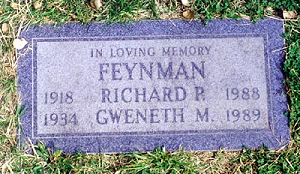RICHARD FEYNMAN, NOBEL LAUREATE IN PHYSICS; PROBED SHUTTLE DISASTER
Richard P. Feynman, a Nobel laureate in physics, best-selling author and former member of the presidential commission that investigated the Challenger disaster, died Monday night in Los Angeles. He was 69.
Mr. Feynman, who died at the University of California at Los Angeles Medical Center after an eight-year battle with abdominal cancer, was a popular and energetic lecturer who, despite his illness, continued to teach at the California Institute of Technology until two weeks ago.
Mr. Feynman graduated from the Massachusetts Institute of Technology in 1939 and received his doctorate from Princeton University in 1942. He was a member of the team that developed the first atomic bomb at the Los Alamos Scientific Laboratory.
He was widely known for his insatiable curiosity, gentle wit, brilliant mind and playful temperament. These qualities were clearly evident in his popular 1985 book of reminiscences, “Surely You’re Joking, Mr. Feynman,” which was on the New York Times best-seller list for 14 weeks.
MIT physicist Philip Morrison called Mr. Feynman “the most original theoretical physicist of our time,” according to a report by United Press International. Morrison said Mr. Feynman, who called his Nobel Prize “a pain in the neck,” was “extraordinarily honest with himself and everyone else,” and added that “he didn’t like ceremony or pomposity . . . he was extremely informal. He liked colorful language and jokes.”
Mr. Feynman attracted widespread attention during the Rogers Commission hearings on the Challenger space shuttle accident in 1986. Frustrated by witnesses’ vague answers and by slow bureaucratic procedures, he conducted an impromptu experiment that proved a key point in the investigation: He dunked a piece of the rocket booster’s O-ring material into a cup of ice water and quickly showed that it lost all resiliency at low temperatures.
In the commission’s final report, Mr. Feynman accused the National Aeronautics and Space Administration of “playing Russian roulette” with astronauts’ lives.
His driving curiosity was apparent when, in his last media interview, he told The Boston Globe last year that his work on the shuttle commission had so aroused his interest in the complexities of managing a large organization like NASA that if he were starting his life over, he might be tempted to study management rather than physics.
Ever playful and unintimidated by authority, Mr. Feynman caused consternation in his years with the Manhattan Project, which developed the atomic bomb, by figuring out in his spare time how to pick the locks on filing cabinets that contained classified information. Without removing anything, he left taunting notes to let officials know that their security system had been breached.
Former Caltech president Marvin Goldberger, now director of the Institute for Advanced Study in Princeton, N.J., said Mr. Feynman was “a towering figure in 20th century physics, always curious, always modest, always ebullient, always willing to share his deep insights with students and colleagues.”
He was awarded the Nobel Prize in 1965, along with Shinichero Tomonaga of Japan and Julian Schwinger of Harvard University. The three had worked independently on problems in the theory of quantum electrodynamics, which describes how atoms produce radiation. He reconstructed almost the whole of quantum mechanics and electrodynamics in his own way, deriving a way to analyze atomic interactions through simple diagrams, a method that is still used widely.
He described the theory for a general audience in his 1986 book, “QED: The Strange Theory of Light and Matter.” An earlier textbook, “The Feynman Lectures on Physics,” was published in 1963 and remains a leading text in physics classes.
In “Lectures,” Mr. Feynman responded to charges that scientific understanding detracts from an esthetic appreciation of nature:
“The vastness of the heavens stretches my imagination — stuck on this carousel my little eye can catch one-million-year-old light. A vast pattern — of which I was a part — perhaps my stuff was belched from some forgotten star, as one is belching there . . . It does not do harm to the mystery to know a little about it. Far more marvelous is the truth than any artists of the past imagined!”
Mr. Feynman leaves his wife, Gweneth; a son, Carl; a daughter, Michelle, and a sister, Joan Feynman.
A memorial service will be held at a later date.
Burial: Mountain View Cemetery
Altadena
Los Angeles County
California, USA